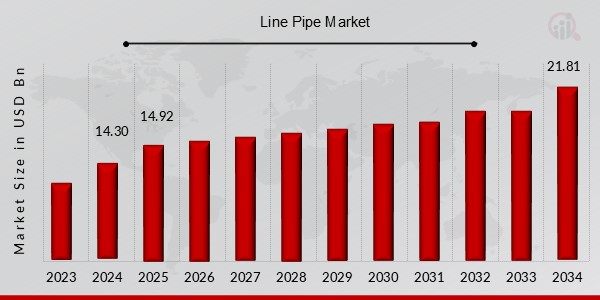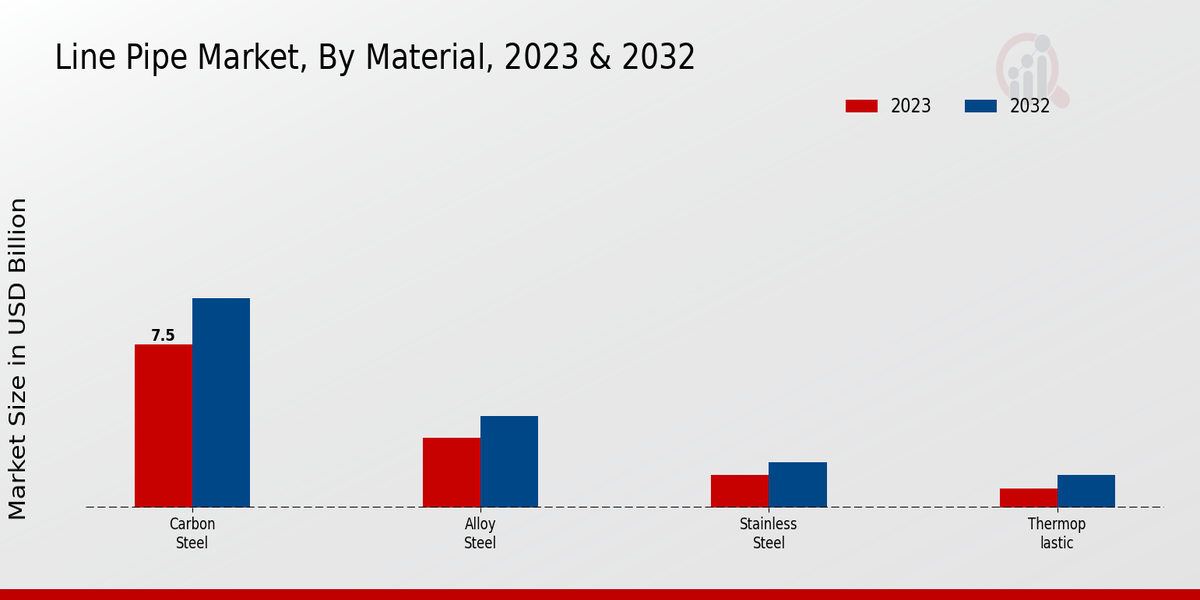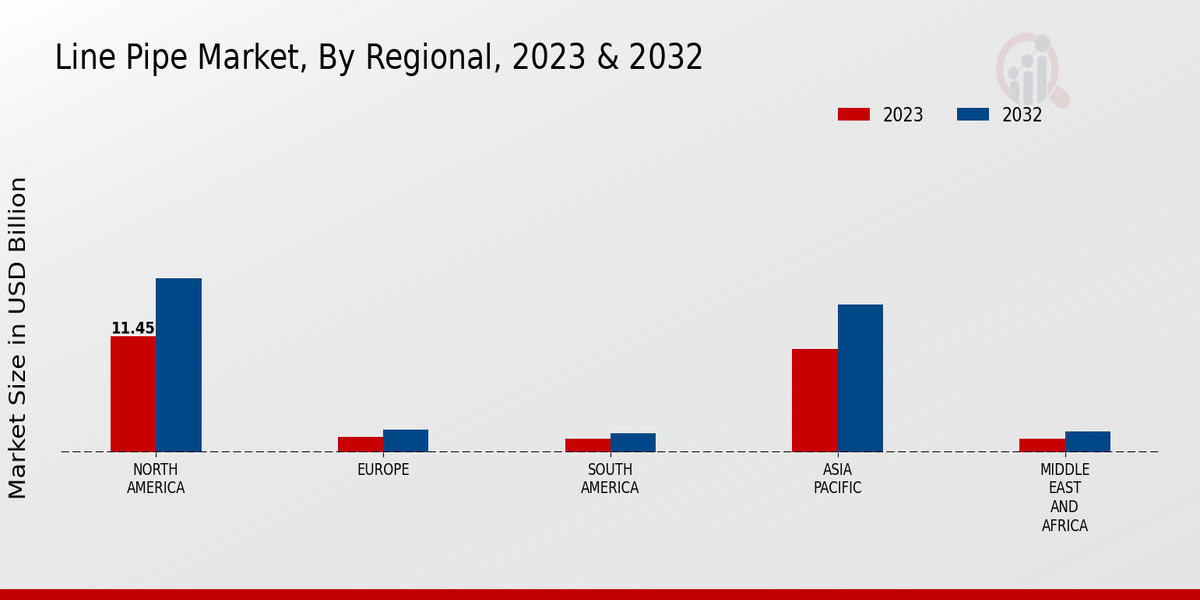Global Line Pipe Market Overview
The Line Pipe Market Size was estimated at 14.30 (USD Billion) in 2024. The Line Pipe Industry is expected to grow from 14.92(USD Billion) in 2025 to 21.81 (USD Billion) by 2034. The Line Pipe Market CAGR (growth rate) is expected to be around 4.3% during the forecast period (2025 - 2034).
Key Line Pipe Market Trends Highlighted
The Line Pipe Market is majorly affected by the increase in the exploration and production of energy resources, especially oil and gas. In addition, expansion plans for gas transmission networks include the construction of additional gas pipelines inside, which creates a steady market for line pipes. Furthermore, the current trend towards renewable energy, even when powering thermodynamic processes, introduces yet another market for the construction of pipelines, including specialized ones for carrying those fluids.
The rise in offshore wind energy market trends offers line pipe makers the opportunity to offer solutions that follow the application’s long-term thermal cycles. The growing concern for energy efficiency coupled with improving technology, especially the use of separation materials like composite pipes and high-strength steel, are also opening new avenues for expansion. Additionally, the increased integration of smart pipeline technology, such as sensors and predictive analytics, is enhancing the development of the industry.
The Line Pipe Market has changed in structure and functionality in the recent past. With the improvements made in drilling technology, the trend of small-diameter pipelines has compelled the manufacturers of line pipes to come up with new designs with thinner wall sections. There has been an increasing need for the materials to be corrosion-resistant in order to accommodate sour gas and other acidic fluids. Furthermore, the use of artificial intelligence and machine learning incorporated in the pipeline monitoring and pipeline maintenance systems is improving the functioning and operating efficiency of the whole system.
Source Primary Research, Secondary Research, MRFR Database and Analyst Review
Line Pipe Market Drivers
Increasing Demand for Oil and Gas
At present, it is notable that as the population continues to rise, the consumption of various types of energy will also increase. Owing to its strategic crisis, there are countries that regard oil and gas more than any other forms of energy. This, correspondingly, creates a higher demand for pipelines in order to deliver such energy. The need for energy is steadily on the rise, particularly in developing nations where the population is increasing rapidly. Forecasts from this agency suggest that the demand for oil is expected to increase at a rate of 1.2% per year from 2024-2032, while the demand for gas is expected to increase at a rate of 1.6% over the same period.
The growth rate of GDP need not justify the above fact with regard to electricity demand. On the contrary, this growth, according to the agency, will mainly stem from the business generated by emerging economies, especially in Asia. The organization also holds the view that the demand for gas in the developed markets will also increase as new gas technologies cool off with the advancement of technology. The oil and gas industry perspective is that this increase in demand for oil and gas will create a boom in pipeline investment, which will favor the industry.
Expansion of Renewable Energy Projects
Another key driver for the Line Pipe Market Industry is the rise in the adoption of renewable energy projects. With time, almost all countries in the world are switching to renewable energy projects, and because of that, the requirements for pipelines to transport renewable energies are on the rise. These requirements are more pronounced in the case of solar and wind energies as they are intermittent sources of energy. Pipelines are also, in general, utilized to both store and dispatch these energies, which makes their importance high.The International Renewable Energy Agency has predicted that investments in renewable energy projects will cross $2.6 trillion globally in 2030. This amount is going to enhance the need and requirements of pipelines to transport renewable energies, thereby benefiting the Line Pipe Market Industry.
Aging Pipeline Infrastructure
The aging pipeline infrastructure is another major driver of the Line Pipe Market Industry. Many pipelines around the world are reaching the end of their useful lives and need to be replaced. This is especially true in developed countries, where energy pipelines have been operational for many years. Replacing aging pipelines is a complex and expensive process, but it is essential for ensuring the safety and reliability of the energy supply.The American Society of Civil Engineers estimates that the United States has a $4.5 trillion backlog of needed investment in water and wastewater infrastructure. This investment is likely to include the replacement of aging pipelines, which will benefit the Line Pipe Market Industry.
Line Pipe Market Segment Insights
Line Pipe Market Material Insights
The Line Pipe Market has been divided by Material into Carbon Steel, Alloy Steel, Stainless Steel, and Thermoplastic. Carbon Steel is the most commonly used material and takes up a significant portion of the market mainly because of its high strength, durability, and low cost. Alloy Steel is also very popular, as it provides even higher strength and corrosion resistance. Stainless Steel is used in some specific applications where corrosion resistance is critical. Thermoplastic is a relatively new material in the Line Pipe market but is becoming more and more popular because of its flexibility and low weight.In 2023, the estimated revenue for Carbon Steel was USD 7.5 billion, and it is expected to grow at a CAGR of 4.1%, reaching USD 9.6 billion by 2032. Alloy Steel is expected to grow from USD 3.2 billion in 2024 to USD 4.2 billion in 2032, with a CAGR of 3.6%. Stainless Steel is expected to grow from USD 1.5 billion in 2023 to USD 2.1 billion in 2032, with a CAGR of 4.0%. Thermoplastic is estimated to be the fastest-growing material, rising from USD 0.9 billion in 2024 to USD 1.5 billion in 2032, with a CAGR of 6.2%. The Line Pipe market is growing due to a variety of factors, including the rising demand for oil and gas, increasing infrastructure development, and the increasing level of industrialization across the globe.Some positive factors also include the continued development of technology, particularly in relation to the development of new materials and manufacturing processes. The market, however, still faces several challenges, such as fluctuating prices of raw materials or competition from alternative materials.

Source Primary Research, Secondary Research, MRFR Database and Analyst Review
Line Pipe Market Diameter Insights
The Line Pipe Market is segmented by diameter, including less than 6 inches, 6-12 inches, 12-18 inches, and greater than 18 inches – where the 6-12 inches segment will hold the largest market share in 2024 owing to the rising demand for line pipes in the oil gas industry. Moreover, the less than 6 inches segment will showcase significant growth owing to the increasing requirement for small-diameter pipes in water distribution and other industrial applications. The 12-18 inches segment is expected to grow at a moderate rate on account of the growing demand for line pipes in the construction industry; however, the greater than 18 inches segment will also witness modest growth owing to the increasing requirement for large diameter pipes in the transportation of oil gas.
Line Pipe Market Application Insights
The Line Pipe Market is segmented into various applications, including Oil and Gas, Water and Wastewater, Chemicals and Petrochemicals, Mining, Power Generation, and Others. Among these, the Oil and Gas segment holds the largest market share, accounting for approximately 55% of the total revenue in 2023. The demand for line pipes in this segment is driven by the increasing exploration and production activities in both onshore and offshore oil and gas fields. The Water and Wastewater segment is expected to witness significant growth in the coming years, owing to rising investments in water infrastructure projects and the need for efficient water transportation and distribution systems.The Chemicals and Petrochemicals segment is also expected to contribute to the market growth, supported by the growing demand for line pipes in chemical processing and transportation applications. Mining, Power Generation, and Other segments are expected to hold a steady share of the market, driven by the demand for line pipes in these industries.
Line Pipe Market End User Industry Insights
The end-user industry segment in the Line Pipe Market comprises various industries that utilize line pipes for their operations. These include Upstream Oil and Gas This industry encompasses activities such as exploration, drilling, and production of crude oil and natural gas. Line pipes are used to transport these resources from wellheads to processing facilities. Downstream Oil and Gas This industry involves the refining, processing, and distribution of crude oil and natural gas. Line pipes are used to transport refined products, such as gasoline, diesel, jet fuel, and petrochemicals, from refineries to distribution centers and end-users.Utilities This industry encompasses companies that provide essential services like water, electricity, and gas to residential, commercial, and industrial customers. Line pipes are used to distribute these fluids and gases to end-users. Industrial This industry includes various manufacturing and processing sectors, such as chemical, pharmaceutical, and food and beverage. Line pipes are used to transport raw materials, intermediates, and finished products within industrial facilities. Construction This industry involves the building and maintenance of infrastructure, including buildings, bridges, and roads.Line pipes are used to transport water, gas, and other fluids to construction sites. Other This segment includes end-user industries not specifically categorized in the above segments, such as mining, shipbuilding, and agriculture. Line pipes are used for various purposes in these industries, such as transporting fluids, gases, and solids. The Line Pipe Market revenue for the end-user industry segment is expected to grow significantly in the coming years, driven by rising investments in energy, infrastructure, and industrial development.
Line Pipe Market Joint Type Insights
The Line Pipe Market is segmented by joint type into beveled, threaded, coupled, and welded. Among these, the welded segment is expected to hold the largest market share in 2023, owing to its advantages, such as high strength, reliability, and cost-effectiveness. The beveled segment is also expected to witness significant growth over the forecast period due to the increasing demand for beveled pipes in oil and gas exploration and transportation applications. The threaded segment is expected to account for a moderate share of the market, while the coupled segment is expected to experience the slowest growth rate during the forecast period.Overall, the Line Pipe Market is expected to grow at a steady pace over the next five years, driven by the increasing demand for line pipes in various industries such as oil and gas, construction, and transportation.
Line Pipe Market Regional Insights
The Line Pipe Market revenue is segmented into various regions such as North America, Europe, APAC, South America, and MEA. Among these regions, North America is expected to dominate the market with a significant share over the forecast period. The region's high demand for oil and gas, along with the presence of major oil and gas companies, is driving the growth of the line pipe market in North America. Europe is another key region for the line pipe market, with a strong presence of oil and gas infrastructure. The region's focus on renewable energy is also expected to contribute to the growth of the line pipe market in Europe.APAC is expected to be the fastest-growing region for the line pipe market, driven by the increasing demand for energy in countries such as China and India. South America and MEA are expected to experience steady growth in the line pipe market, supported by the development of oil and gas infrastructure in these regions.

Source Primary Research, Secondary Research, MRFR Database and Analyst Review
Line Pipe Market Key Players And Competitive Insights
Major players in the Line Pipe Market industry are constantly striving to gain a competitive edge by adopting various strategies such as product innovation, mergers and acquisitions, and geographical expansion. Leading Line Pipe Market players are focusing on developing advanced and cost-effective products to cater to the evolving needs of customers. The Line Pipe Market development is driven by increasing demand for line pipes in various industries, including oil and gas, water and wastewater, and construction. The Line Pipe Market Competitive Landscape is characterized by the presence of both and regional players, each with its own strengths and strategies.A leading player in the Line Pipe Market is Tenaris. The company has a strong presence and offers a wide range of line pipes for various applications. Tenaris is known for its innovative products and its commitment to quality and customer satisfaction. The company has been involved in several major projects worldwide and has a proven track record of delivering high-quality products and services. Tenaris is also actively involved in research and development to enhance its product offerings and meet the changing needs of the market.A competitor in the Line Pipe Market is Vallourec. The company is headquartered in France and has a strong presence in Europe, the Middle East, and Asia. Vallourec offers a wide range of line pipes for various applications, including oil and gas, water and wastewater, and construction. The company is known for its high-quality products and its focus on innovation. Vallourec has been involved in several major projects worldwide and has a strong track record of delivering reliable products and services. The company is also actively involved in research and development to enhance its product offerings and meet the evolving needs of the market.
Key Companies in the Line Pipe Market Include
- TMK
- Severstal
- Nippondenso Co., Ltd
- Salzgitter Mannesmann Line Pipe GmbH
- Europipe GmbH
- Tenaris
- Jindal Saw Ltd
- JFE Steel Corporation
- OMK
- Sumitomo Metal Industries, Ltd
- Welspun Corp. Ltd
- Vallourec
- Valin Corporation
Line Pipe Market Industry Developments
The line pipe market is expected to grow from USD 13.14 billion in 2023 to USD 19.2 billion by 2032, at a CAGR of 4.31% over the forecast period. The growth of the market is attributed to increasing demand for line pipes in oil and gas, water and wastewater, and other infrastructure projects. The increasing population and urbanization are leading to a rise in demand for water and wastewater infrastructure, which is expected to drive the demand for line pipes. Additionally, the growing demand for oil and gas is expected to drive the demand for line pipes for the transportation and distribution of oil and gas products.
Line Pipe Market Segmentation Insights
- Line Pipe Market Material Outlook
- Carbon Steel
- Alloy Steel
- Stainless Steel
- Thermoplastic
- Line Pipe Market Diameter Outlook
- Less than 6 inches
- 6-12 inches
- 12-18 inches
- Greater than 18 inches
- Line Pipe Market Application Outlook
- Oil and Gas
- Water and Wastewater
- Chemicals and Petrochemicals
- Mining
- Power Generation
- Other
- Line Pipe Market End User Industry Outlook
- Upstream Oil and Gas
- Downstream Oil and Gas
- Utilities
- Industrial
- Construction
- Other
- Line Pipe Market Joint Type Outlook
- Beveled
- Threaded
- Coupled
- Welded
- Line Pipe Market Regional Outlook
- North America
- Europe
- South America
- Asia Pacific
- Middle East and Africa
| Report Attribute/Metric |
Details |
| Market Size 2024 |
14.30(USD Billion) |
| Market Size 2025 |
14.92(USD Billion) |
| Market Size 2034 |
21.81(USD Billion) |
| Compound Annual Growth Rate (CAGR) |
4.3% (2024 - 2032) |
| Report Coverage |
Revenue Forecast, Competitive Landscape, Growth Factors, and Trends |
| Base Year |
2024 |
| Market Forecast Period |
2025 - 2034 |
| Historical Data |
2020 - 2024 |
| Market Forecast Units |
USD Billion |
| Key Companies Profiled |
TMK, Severstal, Nippondenso Co., Ltd, Salzgitter Mannesmann Line Pipe GmbH, Europipe GmbH, Tenaris, Jindal Saw Ltd, JFE Steel Corporation, OMK, Sumitomo Metal Industries, Ltd, Welspun Corp. Ltd, Vallourec, Valin Corporation |
| Segments Covered |
Material, Diameter, Application, End User Industry, Joint Type, Regional |
| Key Market Opportunities |
Increased demand for oil and gas Expansion of pipeline networks Growing investments in renewable energy Technological advancements in manufacturing Rise in infrastructure development |
| Key Market Dynamics |
Rising energy demand pipeline infrastructure expansion, growing oil and gas exploration technological advancements and environmental regulations |
| Countries Covered |
North America, Europe, APAC, South America, MEA |
Frequently Asked Questions (FAQ) :
The Line Pipe Market is anticipated to be valued at approximately USD 14.30 billion in 2024.
The Line Pipe Market is projected to grow at a CAGR of 4.3% from 2025 to 2034.
North America is expected to account for the largest share of the Line Pipe Market in 2023.
Increasing demand for oil and gas transportation and growing infrastructure investment are driving the growth of the Line Pipe Market.
Major players in the Line Pipe Market include Vallourec, Tenaris, and JFE Steel.
Line Pipes are primarily used for transporting oil, gas, and water.
The Line Pipe Market is projected to reach a value of around USD 21.81 billion by 2034.
The Asia-Pacific region is anticipated to experience the highest growth in the Line Pipe Market.
Fluctuating raw material prices and intense competition pose challenges to the Line Pipe Market.
Growing demand for energy and infrastructure development presents opportunities for the Line Pipe Market.
















